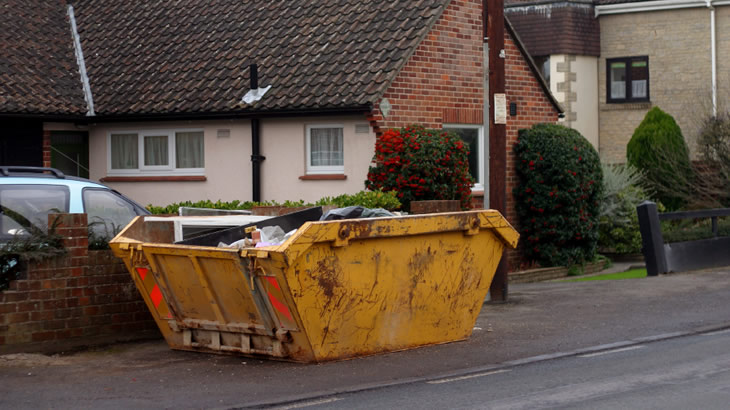Construction skip
Contents |
[edit] Introduction
In construction, a skip is a container that is used for holding waste and debris produced by works such as building, demolition, landscaping, and so on. When full it is loaded onto the back of a lorry and taken away for the waste to be disposed of. A skip may also be used to deliver materials to site before then being used as waste storage.
Skips typically have two trapezoid sides, the shorter edge at the bottom and the longer edge at the top. This results in sloping faces at both ends, sometimes with hinges allowing them to be opened for manual loading or unloading. Lugs on each of the top corners allow chains to be attached so they can be lifted on and off lorries.
[edit] Materials
Skips are suitable for the following materials:
- General waste.
- Inert materials such as concrete, aggregates, ceramics, steel and so on.
- Spoil and soil waste.
- Recyclable materials.
Some of the materials and items that are not suitable for skips include:
- Asbestos and other hazardous materials.
- Batteries, fluorescent tubes, gas canisters, and so on.
- Electrical appliances and equipment.
- Cooling equipment and air conditioning units.
- Liquids such as oil, petrol, paint and so on.
[edit] Skip types and sizes
Types of skip include:
- Open skip: The most common type, which has no top and is often referred to as a ‘builder’s skip’.
- Closed skip: Has a top which makes it more secure and means that it cannot be over-filled.
- Roll-on roll-off (RORO) skip: Similar to open skips but are rolled on and off lorries with a hook rather than being lifted with chains.
- Mobile skip: Set on a four-wheeled trailer.
Skips are available in several different sizes. In the UK, the volume measurement for a skip is still the cubic yard instead of being metric. Sizes include:
- Mini skip: 2 cubic yards (approx. 20-30 bin bags), suitable for small domestic works.
- Small skip: 4 cubic yards (approx. 30-40 bin bags), suitable for small-scale works.
- Small builder’s skip: 6 cubic yards (approx. 50-60 bin bags).
- Large builder’s skip: 8 cubic yards (approx. 60-80 bin bags), this is the most common size.
- Maxi skip: 12 cubic yards (approx. 100-120 bin bags), used for larger works.
[edit] Hiring a skip
Hiring a skip is an important part of site waste management and efficient waste disposal. The larger they are, the are cheaper per cubic yard of waste removed, but if the skip is too large for the amount of waste then it will not be fully used.
When deciding on a skip operator, it is worthwhile checking with the Environment Agency that they are correctly licenced to carry waste. This can be done by acquiring their waste carrier licence number and checking its validity. It may also be sensible to acquire a copy of the operator’s public liability insurance details, in case of accidents or damage to property when delivering or collecting the skip.
If a skip is to be placed on a public highway, a skip hire permit should be applied for and if necessary, a parking suspension put in place. Councils may not permit maxi skips to be placed on a public highway.
Skips will generally have to comply with local authority requirements relating to positioning, signage, lighting and so on.
For more information, see Getting a skip hire permit.
Skips are typically collected within 1 or 2 weeks of them being delivered, but this can generally be adjusted on request. Prices for skip hire will vary depending on locaion, duration, size, the type of material being stored. It is important to ensure that the skip is not overfilled. Instead it should be filled till it is level. If it is overfilled, the operator may charge more to take it away or ask that excess waste is removed.
[edit] Related articles on Designing Buildings
Featured articles and news
The UK's Modern Industrial Strategy: A 10 year plan
Previous consultation criticism, current key elements and general support with some persisting reservations.
Building Safety Regulator reforms
New roles, new staff and a new fast track service pave the way for a single construction regulator.
Architectural Technologist CPDs and Communications
CIAT CPD… and how you can do it!
Cooling centres and cool spaces
Managing extreme heat in cities by directing the public to places for heat stress relief and water sources.
Winter gardens: A brief history and warm variations
Extending the season with glass in different forms and terms.
Restoring Great Yarmouth's Winter Gardens
Transforming one of the least sustainable constructions imaginable.
Construction Skills Mission Board launch sector drive
Newly formed government and industry collaboration set strategy for recruiting an additional 100,000 construction workers a year.
New Architects Code comes into effect in September 2025
ARB Architects Code of Conduct and Practice available with ongoing consultation regarding guidance.
Welsh Skills Body (Medr) launches ambitious plan
The new skills body brings together funding and regulation of tertiary education and research for the devolved nation.
Paul Gandy FCIOB announced as next CIOB President
Former Tilbury Douglas CEO takes helm.
UK Infrastructure: A 10 Year Strategy. In brief with reactions
With the National Infrastructure and Service Transformation Authority (NISTA).
Ebenezer Howard: inventor of the garden city. Book review.
The Grenfell Tower fire, eight years on
A time to pause and reflect as Dubai tower block fire reported just before anniversary.
Airtightness Topic Guide BSRIA TG 27/2025
Explaining the basics of airtightness, what it is, why it's important, when it's required and how it's carried out.
Construction contract awards hit lowest point of 2025
Plummeting for second consecutive month, intensifying concerns for housing and infrastructure goals.
Understanding Mental Health in the Built Environment 2025
Examining the state of mental health in construction, shedding light on levels of stress, anxiety and depression.






















